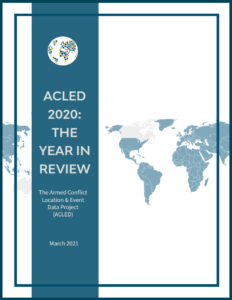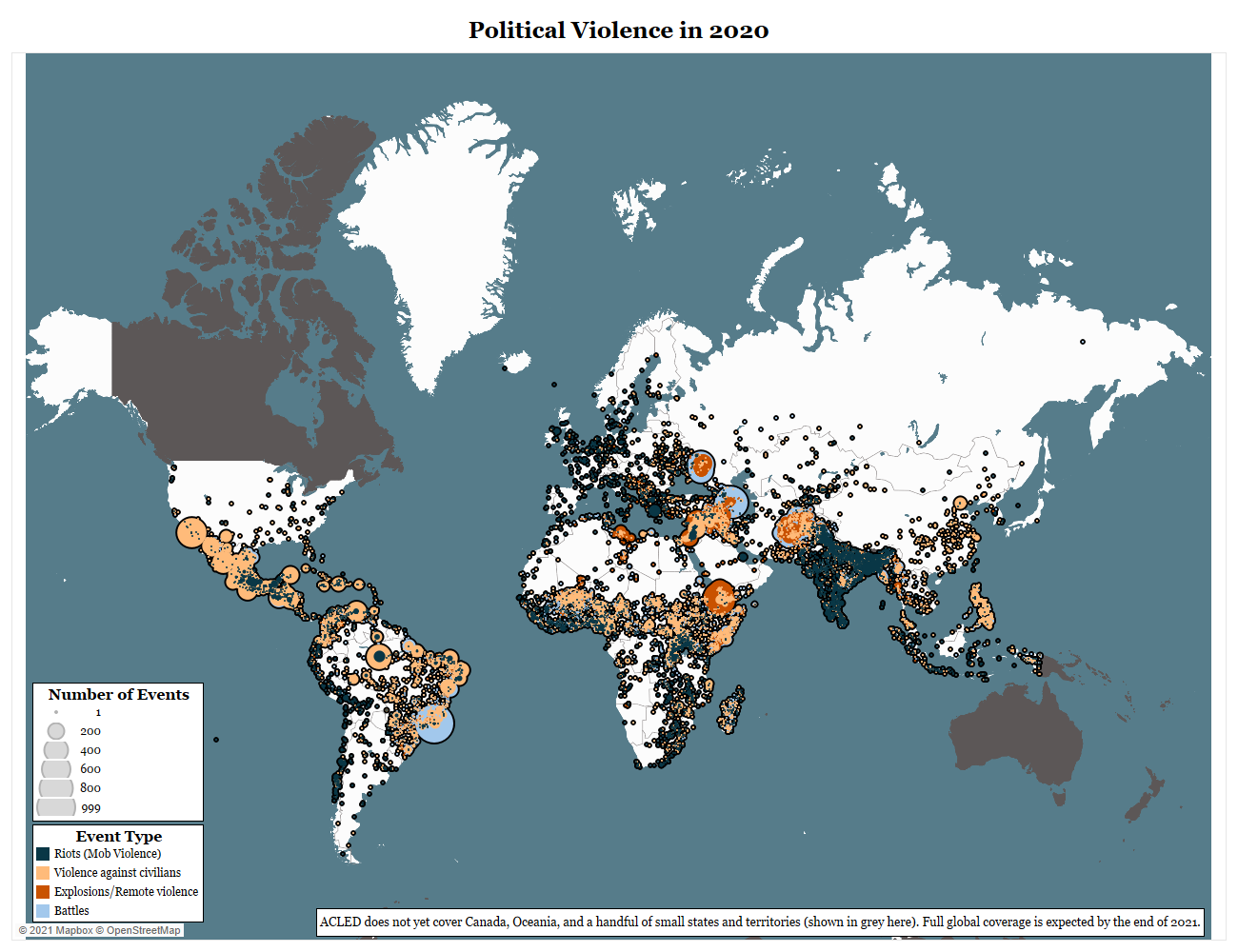ACLED’s 2020 annual report reviews the past year of data on political violence and demonstration activity around the world. Access the full report as well as an executive summary of key findings below.
Executive Summary
One year since the official start of the pandemic in March 2020, COVID-19 has killed more than two million people and brought at least half the earth’s population under lockdown (New York Times, 11 March 2021; New York Times, 3 April 2020). The health crisis has had major impacts on worldwide conflict and disorder patterns, contributing to an overall decrease in political violence levels last year even as it fueled an increase in demonstration activity. And while the pandemic’s effects have been global in scale, they have not been felt equally across conflict contexts: although violence declined on the aggregate level, it rose in nearly half the world’s countries. As vaccine distribution accelerates and countries relax public health restrictions, conflict levels are expected to increase throughout 2021(for more, see ACLED’s special report: Ten Conflicts to Worry About in 2021).
Last year, ACLED expanded data collection to Latin America and the Caribbean, East Asia, the United States, and all of Europe, achieving near global coverage. Our 2020 annual report reviews the past 12 months of data on political violence and demonstration activity around the world.
Key Findings
Overall conflict levels decreased. Political violence decreased by approximately 22% — or 24,539 events — compared to 2019. ACLED records 113,170 events in 2019, relative to 88,631 in 2020. Political violence decreased in every region of the world covered by ACLED, except for Africa. Fatalities from political violence decreased by 19%, from 145,883 in 2019 to 118,429 in 2020. Fatalities declined in every region save for Africa.
Still, political violence increased in more countries than it decreased. While political violence decreased worldwide on an aggregate level, it increased in nearly half the world’s countries: violence rose in 49% of all countries covered by ACLED in 2020, whereas it declined in 48%. Political violence levels held steady in the remaining 3%.
Conventional conflicts continued to rage. The countries that registered the highest number of political violence events in 2020 are predominantly those experiencing conventional conflicts, like Syria, Yemen, Ukraine, and Afghanistan. That Mexico also tops the list reveals how the country’s gang violence has created a conflict environment that rivals an active warzone. All of these countries, with the exception of Ukraine, additionally registered the highest numbers of fatalities in 2020, underscoring the continued lethality of these ongoing conflicts. At the same time, many of these countries also experienced the largest overall declines in conflict activity in 2020. That they continue to top the list of most violent countries speaks to the persistence of these conflicts amid the COVID-19 pandemic.
State forces remained the most active conflict agents. Despite the continued rise of violent non-state actors, state forces participated in over half — 52% — of all political violence last year. Three of the five most active conflict agents in 2020 were state forces operating domestically.
Identity militia activity is on the rise. Nearly all types of conflict actors reduced their activity overall between 2019 and 2020, except for identity militias. Identity militias are the only actor type that increased their engagement in violence. Identity militias — which ACLED defines as armed groups organized around a collective, common feature including community, ethnicity, region, religion, or livelihood — include the Dan Na Ambassagou ethnic Dogon militia in Mali, the Tribal Mobilization Forces in Iraq, and the Volunteers for Defense of Homeland in Burkina Faso. There was a proliferation of identity militias in Africa especially last year, with a 46% increase in the number of distinct, named identity militias active in 2020 relative to 2019.
While both civilian targeting and civilian fatalities decreased on the aggregate level, civilian targeting events increased in half of all countries. Civilians continued to come under attack in a variety of contexts, from conventional conflicts in Syria and Yemen, to gang wars in Mexico and Brazil. In some spaces, civilians came under multiple concurrent threats, such as in India, where they faced persistent mob and communal violence as well as conflicts in Kashmir and the Red Corridor. The greatest increases in civilian targeting were recorded in Brazil, Nigeria, Iraq, the Democratic Republic of Congo, and Cameroon. Overall, civilian targeting rose in 50% of all countries covered by ACLED. Anonymous or unidentified groups were responsible for the largest proportion of civilian targeting around the world last year at 46% of all events, as well as 47% of all reported civilian fatalities. Of identified actors, state forces posed the greatest threat to civilians last year, responsible for 17% of civilian targeting and 15% of civilian fatalities, followed by rioters and violent mobs, which were responsible for 13% of civilian targeting and 3% of civilian fatalities. All forms of civilian targeting decreased from 2019 to 2020, save abductions and forced disappearances, which increased dramatically in Nigeria (by 169%), Yemen (by 114%), Syria (by 36%), and the Democratic Republic of Congo (by 21%).
Despite the pandemic, demonstrations increased worldwide. Following an initial drop at the start of the health crisis, overall demonstration activity rose by 3% in 2020 compared to 2019, with an increase recorded in 58% of all countries covered by ACLED. Approximately 94% of all demonstrations were peaceful, while 8% were met with some form of intervention — an increase in the proportion of demonstrations that were peaceful, and a decline in the proportion of demonstrations met with intervention, relative to the year prior. Demonstrations were also less deadly in 2020: ACLED records a 38% decline in the number of fatalities reported during demonstrations last year, particularly in the Middle East, driven by a decrease in the lethality of violence reported at demonstrations in Iraq and Iran. As ACLED’s coverage of the United States does not yet extend to 2019, data on American demonstration trends are not included in the comparison figures above. However, in 2020, the United States registered the highest number of demonstrations in the world, with nearly as many demonstrations as the next two countries — India and Pakistan — combined.
Update, 2 August 2021: Statistics on civilian targeting perpetrated by unidentified groups as well as global demonstration activity have been updated to reflect new information incorporated into the latest data.







